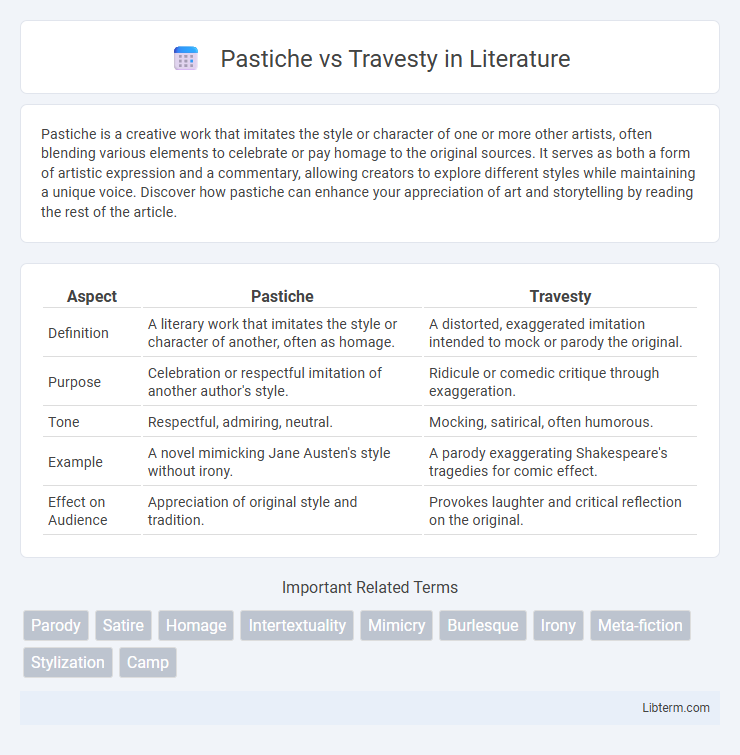Pastiche is a creative work that imitates the style or character of one or more other artists, often blending various elements to celebrate or pay homage to the original sources. It serves as both a form of artistic expression and a commentary, allowing creators to explore different styles while maintaining a unique voice. Discover how pastiche can enhance your appreciation of art and storytelling by reading the rest of the article.
Table of Comparison
| Aspect | Pastiche | Travesty |
|---|---|---|
| Definition | A literary work that imitates the style or character of another, often as homage. | A distorted, exaggerated imitation intended to mock or parody the original. |
| Purpose | Celebration or respectful imitation of another author's style. | Ridicule or comedic critique through exaggeration. |
| Tone | Respectful, admiring, neutral. | Mocking, satirical, often humorous. |
| Example | A novel mimicking Jane Austen's style without irony. | A parody exaggerating Shakespeare's tragedies for comic effect. |
| Effect on Audience | Appreciation of original style and tradition. | Provokes laughter and critical reflection on the original. |
Understanding Pastiche: Definition and Origins
Pastiche is a literary or artistic work that imitates the style or character of another artist or period without mocking it, serving as a respectful homage or tribute. Originating from the Italian word "pasticcio," meaning a mixture or medley, pastiche blends various elements to celebrate diverse influences or styles. It differs from travesty, which distorts or mocks the original work, focusing instead on appreciation and stylistic reverence.
What is Travesty? Key Characteristics
Travesty is a form of literary or artistic work that deliberately distorts or exaggerates a serious subject to create a grotesque or absurd effect. Key characteristics include parodying original material through exaggerated imitation, employing humor or satire to undermine the seriousness of the source, and often highlighting the ridiculous aspects of the subject matter. Unlike pastiche, which respectfully imitates style or genre, travesty intentionally mocks and ridicules the original content.
Pastiche vs Travesty: Core Differences
Pastiche involves imitating the style or characteristics of another work, often as a respectful homage, while travesty distorts or exaggerates the original material for a satirical or humorous effect. Pastiche celebrates the original by blending various elements without mockery, whereas travesty aims to ridicule or critique by presenting a grotesque version. The core difference lies in intent: pastiche honors the original form, whereas travesty seeks to undermine or lampoon it.
Historical Development of Pastiche and Travesty
Pastiche originated in Renaissance literature as a deliberate imitation of various classical styles to honor revered authors, evolving through the centuries into a multifaceted technique used in postmodern art and literature to blend diverse influences. Travesty emerged in the 18th century as a satirical form that deliberately distorted serious works, often in drama and poetry, to create humor and critique societal norms. Both forms reflect changing cultural attitudes toward originality and parody, with pastiche embracing homage and pastiche, while travesty emphasizes ridicule and subversion.
Stylistic Features of Pastiche
Pastiche combines multiple stylistic elements from various sources, often celebrating or imitating the original works with respect and meticulous detail. It frequently employs parody, satire, or homage, showcasing a blend of genres, tones, or authors' distinctive techniques without distorting their core intent. This stylistic complexity distinguishes pastiche as a creative collage rather than a distorted pastiche or exaggerated travesty.
Elements That Define Travesty
Travesty is characterized by the distortion or grotesque imitation of a serious work, often through exaggerated characters, absurd situations, and a satirical tone that mocks the original. Key elements defining travesty include deliberate misrepresentation, ludicrous or trivial subject matter, and a purpose to ridicule or undermine the source material. Unlike pastiche, which celebrates through homage, travesty uses parody to expose flaws or critique the original piece.
Famous Examples of Pastiche in Literature and Art
Pastiche in literature and art often imitates or celebrates various styles or works without mocking them, exemplified by works like "The Waste Land" by T.S. Eliot, which blends multiple literary styles and references. In visual art, Pablo Picasso's use of Cubism incorporates elements from African tribal art and classical European painting, creating a pastiche that honors different traditions. This contrasts with travesty, which distorts or parodies the original work for satirical or humorous effect.
Notable Travesties in Popular Culture
Notable travesties in popular culture often involve exaggerated parodies that distort original works for comedic or critical effect, such as Mel Brooks' film *Blazing Saddles* which mocks Western film tropes through absurdity. The TV show *The Simpsons* frequently utilizes travesties by satirizing cultural icons and media formats in a way that exaggerates their flaws to highlight societal issues. These travesties stand in contrast to pastiches, which tend to pay homage to the source material by imitating style without the overt distortion or ridicule characteristic of travesties.
When to Use Pastiche or Travesty in Creative Work
Use pastiche in creative work when the goal is to pay respectful homage or celebrate the style and techniques of an original artist, often blending multiple influences to evoke a particular era or genre. Travesty is suitable when the intent is to parody or mock by exaggerating or distorting features, often for humorous or critical effect. Choosing between pastiche and travesty depends on whether the purpose is admiration and imitation or satire and critique.
Impact of Pastiche and Travesty on Modern Media
Pastiche in modern media fosters creative homage by blending diverse styles, enriching narrative complexity and cultural appreciation. Travesty, by contrast, uses exaggerated imitation to critique or satirize societal norms, provoking critical reflection and humor. Both techniques significantly shape audience engagement and media evolution through their distinct yet complementary influences.
Pastiche Infographic

 libterm.com
libterm.com